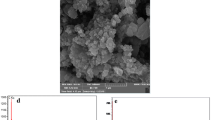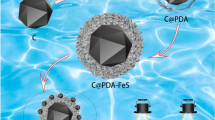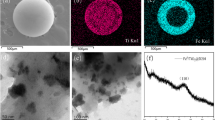Abstract
Magnetic Fe–Cu nanocomposites with high adsorption capacity and photocatalytic properties were prepared via the precursor method using soluble substances isolated from urban biowaste (BBS) as carbon sources and different temperatures of the pyrolysis treatment (400, 600, and 800 °C). BBS is used as complexing agent for the Fe3+ and Cu2+ ions in the precursors. The as-prepared magnetic materials were tested in As(III) removal processes from water. Dark experiments performed with the materials obtained at 400 and 600 °C showed excellent adsorption capacities achieving a significant uptake of 911 and 840 mg g−1 for As(III), respectively. Experiments conducted under steady-state irradiation showed a reduction of 50–71% in As(III) levels evidencing the meaningful photocatalytic capacity of Fe–Cu nanocomposites. The best photocatalytic performance was obtained for the nanocomposite synthesized at the highest pyrolysis temperature, in line with the reported trend of HO· radicals production. Transient absorption spectroscopy experiments revealed the occurrence of an alternative oxidation pathway involving the valence band holes and yielded relevant kinetic information related to the early stages of the As(III) photooxidation. The higher absorption of the electron–hole pairs observed for the samples treated at lower temperature means that controlling the pyrolysis temperature during the synthesis of the Fe–Cu nanocomposites allows tuning the photocatalyst activity for oxidation of substrates via valence band holes, or via HO· radicals.
Graphical abstract







Similar content being viewed by others
References
Alam, M. S., Wu, Y., & Cheng, T. (2014). Silicate minerals as a source of arsenic contamination in groundwater. Water Air Soil Pollution, 225, 1–15. https://doi.org/10.1007/S11270-014-2201-9
Shaji, E., Santosh, M., Sarath, K. V., Prakash, V., Deepchand, P., & Divya, B. V. (2021). Arsenic contamination of groundwater: A global synopsis with focus on the Indian Peninsula. Geoscience Frontier, 12, 101079. https://doi.org/10.1016/j.gsf.2020.08.015
Pham, P., Rashid, M., Cai, Y., Yoshinaga, M., Dionysiou, D. D., & O’Shea, K. (2020). Removal of As(III) from water using the adsorptive and photocatalytic properties of humic acid-coated magnetite nanoparticles. Nanomaterials, 10, 1604. https://doi.org/10.3390/NANO10081604
Bhandari, N., Reeder, R. J., & Strongin, D. R. (2011). Photoinduced oxidation of arsenite to arsenate on ferrihydrite. Environmental Science and Technology, 45, 2783–2789. https://doi.org/10.1021/es103793y
Gillispie, E. C., Sowers, T. D., Duckworth, O. W., & Polizzotto, M. L. (2015). Soil pollution due to irrigation with arsenic-contaminated groundwater: current state of science. Current Pollution Reports, 1, 1–12. https://doi.org/10.1007/s40726-015-0001-5
Mondal, P., Majumder, C. B., & Mohanty, B. (2006). Laboratory based approaches for arsenic remediation from contaminated water: Recent developments. Journal of Hazardous Materials, 137, 464–479. https://doi.org/10.1016/J.JHAZMAT.2006.02.023
Litter, M. I. (2015). Mechanisms of removal of heavy metals and arsenic from water by TiO2-heterogeneous photocatalysis. Pure Applied Chemistry, 87, 557–567. https://doi.org/10.1515/PAC-2014-0710/PDF
Gupta, S. M., & Tripathi, M. (2011). A review of TiO2 nanoparticles. Chinese Science Bulletin, 56, 1639–1657. https://doi.org/10.1007/S11434-011-4476-1
Ahmad, R., Ahmad, Z., Khan, A. U., Mastoi, N. R., Aslam, M., & Kim, J. (2016). Photocatalytic systems as an advanced environmental remediation: Recent developments, limitations and new avenues for applications. Journal of Environmental Chemistry and Engineering, 4, 4143–4164. https://doi.org/10.1016/j.jece.2016.09.009
Peralta, M. E., Ocampo, S., Funes, I. G., Medina, F. O., Parolo, M. E., & Carlos, L. (2020). Nanomaterials with tailored magnetic properties as adsorbents of organic pollutants from wastewaters. Inorganics, 8, 1–25. https://doi.org/10.3390/inorganics8040024
Ibhadon, A. O., & Fitzpatrick, P. (2013). Heterogeneous photocatalysis: Recent advances and applications. Catalysis, 3, 189–218. https://doi.org/10.3390/CATAL3010189
Yu, L., Peng, X., Ni, F., Li, J., Wang, D., & Luan, Z. (2013). Arsenite removal from aqueous solutions by γ-Fe2O3-TiO2 magnetic nanoparticles through simultaneous photocatalytic oxidation and adsorption. Journal of Hazardous Materials, 246–247, 10–17. https://doi.org/10.1016/J.JHAZMAT.2012.12.007
Aparicio, F., Mizrahi, M., Ramallo-López, J. M., Laurenti, E., Magnacca, G., Carlos, L., & Mártire, D. O. (2022). Novel bimetallic magnetic nanocomposites obtained from waste-sourced bio-based substances as sustainable photocatalysts. Materials Research Bulletin. https://doi.org/10.1016/j.materresbull.2022.111846
Magnacca, G., Allera, A., Montoneri, E., Celi, L., Benito, E., Gagliardi, L. G., Gonzalez, C., Martire, D. O., & Carlos, L. (2014). Novel magnetite nanoparticles coated with waste-sourced biobased substances as sustainable and renewable adsorbing materials. ACS Sustainable Chemistry and Engineering, 2(6), 1518–1524. https://doi.org/10.1021/sc500213j
Franzoso, F., Nisticò, R., Cesano, F., Corazzari, I., Turci, F., Scarano, D., Bianco Prevot, A., Magnacca, G., Carlos, L., & Mártire, D. O. (2017). Biowaste-derived substances as a tool for obtaining magnet-sensitive materials for environmental applications in wastewater treatments. Chemical Engineering Journal, 310, 307–316. https://doi.org/10.1016/j.cej.2016.10.120
Gomis, J., Vercher, R. F., Amat, A. M., Mártire, D. O., González, M. C., Bianco Prevot, A., Montoneri, E., Arques, A., & Carlos, L. (2013). Application of soluble bio-organic substances (SBO) as photocatalysts for wastewater treatment: Sensitizing effect and photo-Fenton-like process. Catalysis Today, 209, 176–180. https://doi.org/10.1016/j.cattod.2012.08.036
Aparicio, F., Escalada, J. P., De Gerónimo, E., Aparicio, V. C., Einschlag, F. S. G., Magnacca, G., Carlos, L., & Mártire, D. O. (2019). Carbamazepine degradation mediated by light in the presence of humic substances-coated magnetite nanoparticles. Nanomaterials, 9, 1–12. https://doi.org/10.3390/nano9101379
Snellenburg, J. J., Laptenok, S., Seger, R., Mullen, K. M., & van Stokkum, I. H. M. (2012). Glotaran: A Java-based graphical user interface for the R package TIMP. Journal of Statistical Software, 49, 1–22. https://doi.org/10.18637/JSS.V049.I03
Pecini, E. M., Springer, V., Brigante, M., & Avena, M. (2017). Arsenate interaction with the surface of nanomagnetic particles. High adsorption or full release. Journal of Environmental Chemical Engineering, 5, 4917–4922. https://doi.org/10.1016/j.jece.2017.09.020
Su, H., Ye, Z., Hmidi, N., & Subramanian, R. (2017). Carbon nanosphere–iron oxide nanocomposites as high-capacity adsorbents for arsenic removal. RSC Advances, 7, 36138–36148. https://doi.org/10.1039/C7RA06187K
Gong, X. J., Li, Y. S., Dong, Y. Q., & Li, W. G. (2020). Arsenic adsorption by innovative iron/calcium in-situ-impregnated mesoporous activated carbons from low-temperature water and effects of the presence of humic acids. Chemosphere, 250, 126275. https://doi.org/10.1016/j.chemosphere.2020.126275
Nisticò, R., Celi, L. R., Bianco Prevot, A., Carlos, L., Magnacca, G., Zanzo, E., & Martin, M. (2018). Sustainable magnet-responsive nanomaterials for the removal of arsenic from contaminated water. Journal of Materials Chemistry, 342, 260–269. https://doi.org/10.1016/j.jhazmat.2017.08.034
Zhang, F. S., & Itoh, H. (2006). Photocatalytic oxidation and removal of arsenite from water using slag-iron oxide-TiO2 adsorbent. Chemosphere, 65, 125–131. https://doi.org/10.1016/J.CHEMOSPHERE.2006.02.027
Rosales, M., Orive, J., Espinoza-González, R., Fernández de Luis, R., Gauvin, R., Brodusch, N., Rodríguez, B., Gracia, F., & García, A. (2021). Evaluating the bi-functional capacity for arsenic photo-oxidation and adsorption on anatase TiO2 nanostructures with tunable morphology. Chemical Engineering Journal, 415, 128906. https://doi.org/10.1016/j.cej.2021.128906
Guan, X., Du, J., Meng, X., Sun, Y., Sun, B., & Hu, Q. (2012). Application of titanium dioxide in arsenic removal from water: A review. Journal of Hazardous Materials, 215–216, 1–16. https://doi.org/10.1016/J.JHAZMAT.2012.02.069
Ryu, J., Monllor-Satoca, D., Kim, D. H., Yeo, J., & Choi, W. (2013). Photooxidation of arsenite under 254 nm irradiation with a quantum yield higher than unity. Environmental Science and Technology, 47(16), 9381–9387. https://doi.org/10.1021/ES402011G
Baldoví, H. G., Ferrer, B., Álvaro, M., & García, H. (2014). Microsecond transient absorption spectra of suspended semiconducting metal oxide nanoparticles. The Journal of Physical Chemistry C, 118, 9275–9282. https://doi.org/10.1021/JP5018345
Zhang, L., Mohamed, H. H., Dillert, R., & Bahnemann, D. (2012). Kinetics and mechanisms of charge transfer processes in photocatalytic systems: A review. Journal of Photochemistry and Photobiology C: Photochemistry Reviews, 13, 263–276. https://doi.org/10.1016/j.jphotochemrev.2012.07.002
Pellegrin, Y., & Odobel, F. (2017). Sacrificial electron donor reagents for solar fuel production. Comptes Rendus Chimie, 20, 283–295. https://doi.org/10.1016/J.CRCI.2015.11.026
Caregnato, P., Bertolotti, S. G., Gonzalez, M. C., & Mártire, D. O. (2005). Water/silica nanoparticle interfacial kinetics of sulfate, hydrogen phosphate, and dithiocyanate radicals. Photochemistry and Photobiology, 81, 1526–1533. https://doi.org/10.1562/2005-07-07-RA-603
Rodríguez, N. A., Savateev, A., Grela, M. A., & Dontsova, D. (2017). Facile synthesis of potassium poly(heptazine imide) (PHIK)/Ti-based metal-organic framework (MIL-125-NH2) composites for photocatalytic applications. ACS Applied Materials and Interfaces, 9, 22941–22949. https://doi.org/10.1021/ACSAMI.7B04745
Ma, J., Zhu, C., Lu, J., Ouyang, B., Xie, Q., Liu, H., Peng, S., & Chen, T. (2017). Kinetics analysis of interfacial electron-transfer processes in goethite suspensions systems. Chemosphere, 188, 667–676. https://doi.org/10.1016/J.CHEMOSPHERE.2017.09.029
Esteves, M. A., Fresno, F., Fernandes, V. R., Oropeza, F. E., De la Peña O’Shea, V. A., & Rangel, C. M. (2021). TiO2-reduced graphene oxide-Pt nanocomposites for the photogeneration of hydrogen from ethanol liquid and gas phases. Catalysis Today, 380, 41–52. https://doi.org/10.1016/j.cattod.2021.05.012
Acknowledgements
This project has received funding from the European Union’s Horizon 2020 research and innovative program under the Marie Sklodowska-Curie Grant agreement no. 645551 and from ANPCyT, Argentina (PICT 2016-0974, PICT 2017-1628, and PICT 2019-03140). L. Morán Ayala and F. Aparicio thank CONICET for their research graduate grants. L. Carlos and G. Bosio are research members of CONICET (Argentina). D. Mártire is a research member of CIC (Buenos Aires, Argentina).
Author information
Authors and Affiliations
Corresponding authors
Ethics declarations
Conflict of interest
There are no conflicts of competing interest to declare.
Additional information
This paper is part of the Special Issue dedicated to Prof. Silvia E. Braslavsky on the occasion of her 80th birthday.
Supplementary Information
Below is the link to the electronic supplementary material.
Rights and permissions
Springer Nature or its licensor (e.g. a society or other partner) holds exclusive rights to this article under a publishing agreement with the author(s) or other rightsholder(s); author self-archiving of the accepted manuscript version of this article is solely governed by the terms of such publishing agreement and applicable law.
About this article
Cite this article
Ayala, L.I.M., Aparicio, F., Boffa, V. et al. Removal of As(III) via adsorption and photocatalytic oxidation with magnetic Fe–Cu nanocomposites. Photochem Photobiol Sci 22, 503–512 (2023). https://doi.org/10.1007/s43630-022-00330-z
Received:
Accepted:
Published:
Issue Date:
DOI: https://doi.org/10.1007/s43630-022-00330-z




